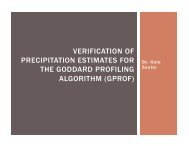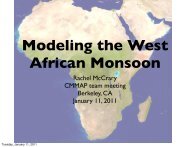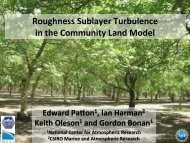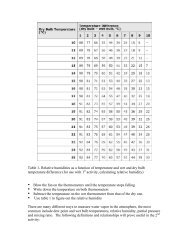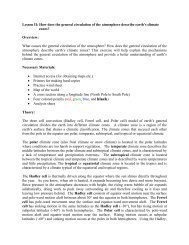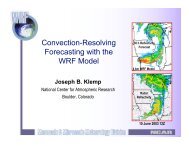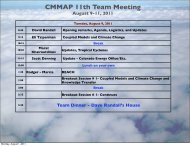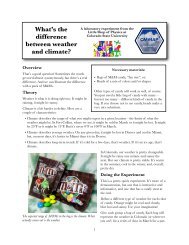Climate during the Paleocene-Eocene Thermal Maximum ... - cmmap
Climate during the Paleocene-Eocene Thermal Maximum ... - cmmap
Climate during the Paleocene-Eocene Thermal Maximum ... - cmmap
You also want an ePaper? Increase the reach of your titles
YUMPU automatically turns print PDFs into web optimized ePapers that Google loves.
<strong>Climate</strong> <strong>during</strong> <strong>the</strong> <strong>Paleocene</strong>-<strong>Eocene</strong> <strong>Thermal</strong><br />
<strong>Maximum</strong> (PETM) as simulated by <strong>the</strong> SP-CAM<br />
Marat Khairoutdinov<br />
Stony Brook University<br />
Long Island, NY
The latest figures suggest that we are on track<br />
with <strong>the</strong> worst case scenario of CO2 emissions<br />
from <strong>the</strong> IPCC AR4<br />
IEA global human CO2 annual emissions from fossil fuels estimates vs. IPCC SRES<br />
scenario projections.<br />
International Energy Agency report, June 2011
At such a ‘business-as-usual’ rate, <strong>the</strong> CO2 concentrations could<br />
reach 800 to 1000 ppmv by 2100, which means tripling not doubling<br />
CO2 levels with respect to preindustrial levels.<br />
In 2100: 850-950
According to paleo reconstructions, it has been tens of millions of years since<br />
<strong>the</strong> Earth had <strong>the</strong> levels of CO2 and corresponding radiative forcing that we<br />
may experience in just 90 years from now.<br />
Reconstruction of <strong>the</strong> CO2 levels over <strong>the</strong><br />
past 45 million years<br />
The net radiative forcing due to changes in atmospheric CO2<br />
concentration and total solar irradiance over <strong>the</strong> past 45<br />
million years.<br />
Kiehl (Science, 2011)<br />
Pagani et al (Science, 2005)
Perhaps we can use <strong>the</strong> past to tell us what is waiting for us in <strong>the</strong> future...<br />
Rate of temperature change today (red) and in <strong>the</strong> PETM (blue)<br />
PETM
Earth 55 million years ago <strong>during</strong> <strong>Paleocene</strong>-<strong>Eocene</strong> <strong>Thermal</strong> <strong>Maximum</strong> (PETM)<br />
• Global mean temperature about 30 o C (vs. 14 o C today);<br />
• CO2 range: 1700 to 2250 ppmv (vs. 380 today);<br />
• Lasted 200,000 years; <strong>the</strong> cause is still a mystery;<br />
• Mammalian abundance; primates and horse orders first appeared.<br />
• GCMs have unexplained ‘cold poles’ bias compared to reconstructed T<br />
Geographical reconstruction for <strong>the</strong> PETM from <strong>the</strong> PALEOMAP Project (www.scotese.com) . Boxes indicate reconstructed surface temperature<br />
anomalies for <strong>the</strong> PETM relative to <strong>Paleocene</strong> background temperatures
SP-CAM Set-up<br />
• All run-datasets including initial conditions, prescribed monthly SST climatology, orbital<br />
parameters, PETM paleogeography, paleotopography, and vegetation reconstruction were<br />
courteously provided by Jeff Kiehl and Christina Shields from <strong>the</strong>ir PETM multi-millennium<br />
simulations with fully coupled CCSM3;<br />
• GCM: SP-CAM T31 L26; CRM: 4km, 32 cols, L25<br />
• 7 years PETM and control (present);<br />
Parameters<br />
55 MY ago<br />
(PETM)<br />
Present<br />
CO2, ppmv 2250 380<br />
CH4, ppmv 16 1.75<br />
N2O, ppmv 0.275 0.3<br />
Solar constant, W/m 2 1355 1365<br />
Eccentricity 0 0.0167<br />
Obliquity 23.5 23.44
<strong>Maximum</strong>/Minimum Monthly Surface Temperature, o C<br />
PETM (55.8 MY ago)<br />
Present<br />
Max<br />
Min<br />
o<br />
C
Annual Zonal mean Temperature<br />
PETM (55.8 MY ago)<br />
Present
Annual Top-of_Atmosphere Fluxes, W/m 2<br />
• More solar radiation is absorbed in PETM simulation<br />
PETM (55.8 MY ago)<br />
Present<br />
250<br />
OLR<br />
236<br />
253<br />
Solar<br />
240
Annual Cloud Forcing, W/m 2<br />
• In PETM, <strong>the</strong> cooling effect of clouds due to albedo is significantly reduced<br />
PETM (55.8 MY ago)<br />
Present<br />
28 27<br />
OLR<br />
-40 -50<br />
Solar
Annual Cloud Cover (ISCCP Sim), W/m 2<br />
• In PETM, <strong>the</strong> low clouds amount is significantly reduced<br />
PETM (55.8 MY ago)<br />
Present<br />
36 36<br />
High+Mid<br />
14 20<br />
Low
<strong>Maximum</strong> Potential Intensity (MPI) Theory<br />
Emanuel (1995), Bister and Emanuel (1998)<br />
upper bound on tropical cyclone wind speed:<br />
- See-surface temperature<br />
- Mean outflow temperature (close to tropopause temperature)<br />
- bulk surface exchange coefficients for heat and momentum<br />
-convective available potential energy of boundary layer air at <strong>the</strong> radius of maximum wind<br />
-convective available potential energy of surface saturated air at <strong>the</strong> radius of maximum wind
<strong>Maximum</strong> Monthly Emanuel’s Potential Intensity (MPI), m/s<br />
Theoretical estimate of <strong>the</strong> maximum sustained wind in a developed hurricane<br />
Computed from SP-CAM monthly climatology<br />
PETM (55 MY ago)<br />
Present<br />
m/s<br />
Despite much warmer tropical SSTs (by 10 o C!), hurricanes <strong>during</strong> PETM were probably<br />
not stronger that today’s hurricanes; maybe even slightly weaker!
Composite mean profiles of temperature simulated by <strong>the</strong> SP-CAM<br />
at <strong>the</strong> TC genesis regions in Tropics<br />
Present<br />
PETM<br />
• In PETM, <strong>the</strong> tropopause warms up more than twice<br />
as much as <strong>the</strong> surface;<br />
• This tends to reduce efficiency of TCs, and, hence,<br />
reduce MPI.<br />
• However, this could be an artifact of coarse model<br />
resolution of upper troposphere and low stratosphere;<br />
• Higher vertical-resolution simulations should and<br />
will be performed.
Tropical Cyclone Genesis Potential Index (GPI)<br />
Emanuel and Nolan (2004), Camargo et al. (2007)<br />
- absolute vorticity (1/s) at 850 mb<br />
- Relative humidity (%) at 700 mb<br />
- <strong>Maximum</strong> Potential intensity (m/s)<br />
- wind shear between 850 and 200 mb
<strong>Maximum</strong> Monthly TC Genesis Potential Index<br />
based on SP-CAM monthly climatology<br />
Present
<strong>Maximum</strong> Monthly TC Genesis Potential Index<br />
based on SP-CAM monthly climatology<br />
and observed TC/TS genesis locations from <strong>the</strong> BestTrack dataset<br />
for 1970-2010
<strong>Maximum</strong> Monthly TC Genesis Potential Index<br />
based on SP-CAM monthly climatology<br />
There is active subtropical cyclogenesis in <strong>the</strong> PETM!<br />
PETM (55 MY ago)<br />
Present
Kerry Emanuel’s Downscaled Hurricane Climatology<br />
TC genesis positions (independent from GPI)<br />
based on SP-CAM monthly climatology<br />
N<br />
Genesis points, PETM<br />
90N<br />
Genesis points, Control<br />
N<br />
70N<br />
N<br />
50N<br />
N<br />
30N<br />
N<br />
10N<br />
S<br />
10S<br />
S<br />
30S<br />
S<br />
50S<br />
S<br />
70S<br />
S<br />
160W140W120W100W80W 60W 40W 20W 0E 20E 40E 60E 80E 100E120E140E160E180E<br />
90S<br />
40E 60E 80E 100E120E140E160E180E160W140W120W100W80W 60W 40W 20W 0E 20E
Kerry Emanuel’s Downscaled Hurricane Climatology<br />
TC possible tracks<br />
90N<br />
500 PETM tracks<br />
90N<br />
500 tracks, Control<br />
70N<br />
70N<br />
50N<br />
50N<br />
30N<br />
30N<br />
10N<br />
10N<br />
10S<br />
10S<br />
30S<br />
30S<br />
50S<br />
50S<br />
70S<br />
70S<br />
160W140W120W100W 80W 60W 40W 20W 0E 20E 40E 60E 80E 100E 120E 140E 160E 180E<br />
40E 60E 80E 100E120E140E160E180E160W140W120W100W80W 60W 40W 20W 0E 20E
Kerry Emanuel’s Downscaled Hurricane Climatology<br />
• Perhaps surprisingly, despite much warmer SSTs, <strong>the</strong>re are<br />
fewer intense hurricane/tropical storm events <strong>during</strong> PETM<br />
than today ;<br />
• The total number of events is about <strong>the</strong> same as today with<br />
slightly more (by about 10%) events <strong>during</strong> PETM;<br />
• Can large number of extra-tropical TCs <strong>during</strong> PETM<br />
explain ‘cold poles’ bias of GCMs?
Intraseasonal variability <strong>during</strong> PETM<br />
Preliminary look<br />
• Twice as fast Kelvin waves and MJO?






